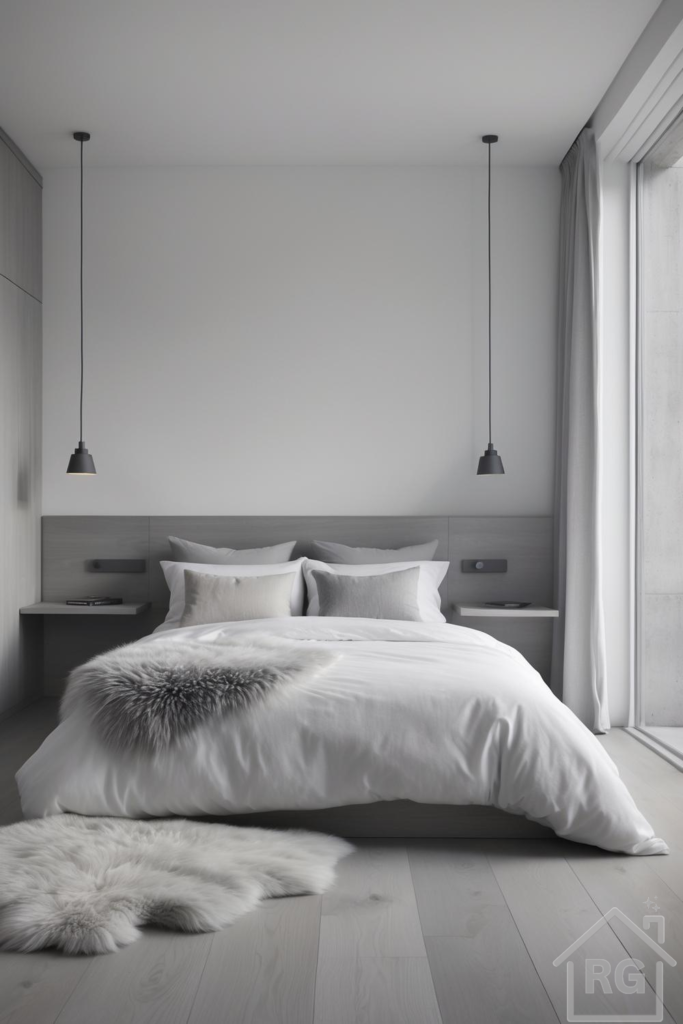
The bedroom is more than just a place to sleep; it’s a sanctuary, a personal retreat from the hustle and bustle of the outside world. In today’s fast-paced life, the appeal of a minimalist bedroom – clean, uncluttered, and calming – is stronger than ever. This design philosophy strips away the non-essential, focusing on simplicity, functionality, and tranquility. Inspired by serene spaces featuring a harmonious blend of grey and white tones, soft textures, and clean lines, this guide will walk you through creating your own minimalist haven.
The Foundation: A Neutral Color Palette
The cornerstone of this minimalist aesthetic is its restrained color palette. Dominated by white and various shades of grey, from soft dove grey to deeper charcoal accents, the scheme creates an immediate sense of calm and sophistication.
- White: Acts as the primary base, reflecting light and making the space feel airy and open. Use crisp white for bedding and potentially ceiling paint to maximize brightness.
- Shades of Grey: Introduce depth and nuance. Lighter greys on walls or curtains maintain the airy feel, while medium greys, like those on the pillows or headboard, add visual interest. Darker greys or black, used sparingly in elements like pendant lights, provide grounding contrast.
- Subtle Warmth: The light, almost grey-washed wood flooring and headboard introduce a subtle warmth, preventing the space from feeling cold or sterile. This touch of natural material is crucial in minimalist design.
When selecting your greys, consider the undertones (cool blue, warm brown, or neutral) and how they interact with the natural light in your room. Layering different shades prevents the monochrome scheme from becoming flat.
The Soul of Minimalism: Texture
With a limited color palette, texture becomes paramount in adding depth, warmth, and personality to a minimalist bedroom. Why? Because it’s the interplay of different surfaces that engages the senses, prevents the space from feeling stark, and creates a truly cozy, inviting atmosphere despite the simplicity.
- Soft Furnishings: The bed is the focal point. Crisp cotton or linen duvet covers provide a smooth, clean base. Layering is key: add pillows in varying shades of grey with subtle textures (like a linen weave or a slight pattern). A masterstroke is often a faux fur or chunky knit throw – its plushness offers a luxurious contrast to the smooth bedding and invites touch.
- Floor Coverings: A soft rug, perhaps faux fur or high-pile wool, can mirror textures on the bed, adding another layer of softness underfoot and defining the sleeping area. It breaks up the expanse of flooring while reinforcing the cozy theme.
- Wood Grain: The natural grain of light wood flooring or furniture provides organic texture and visual interest. Choose woods with subtle grain patterns to maintain the minimalist feel.
- Other Surfaces: Consider matte paint on the walls for a soft, non-reflective finish. Sheer curtains diffuse light beautifully, adding an ethereal quality, while the smooth, cool metal of light fixtures can provide a sleek, modern counterpoint.
Experiment with contrasting textures: smooth against rough, soft against hard. This tactile variation is what makes minimalist design feel rich and considered, not empty.
Furniture: Form Follows Function
Minimalist furniture is characterized by clean lines, simple forms, and a focus on functionality. Remember, clutter is the enemy of serenity.
- Integrated Design: Features like a headboard extending into floating nightstands are brilliant space-saving and visually streamlining solutions. They reduce visual clutter and make cleaning easier.
- Clean Lines: The bed itself should ideally have a simple platform base, hidden or unobtrusive, contributing to a light, airy aesthetic. Avoid ornate details or heavy frames.
- Storage: Effective, hidden storage (like built-in wardrobes or under-bed drawers) is crucial for maintaining a minimalist look by keeping clothes and other items out of sight.
When selecting furniture, prioritize quality over quantity. Each piece should serve a purpose and contribute to the overall calm aesthetic. Look for pieces with simple silhouettes and neutral finishes.
Lighting the Mood
Lighting plays a crucial role in setting the atmosphere of a bedroom. A layered approach using different light sources works best.
- Natural Light: Maximize natural light if possible. Large windows with sheer curtains allow ample daylight to flood the space while maintaining privacy and softness.
- Task Lighting: Pendant lights or wall sconces suspended over nightstands provide focused light for reading or bedside tasks. Their simple, modern design complements the minimalist style, and hanging them frees up surface space.
- Ambient Lighting: Consider recessed ceiling lights or a simple, unobtrusive ceiling fixture for overall room illumination. Always install dimmer switches to allow for mood control – bright light for waking up, soft light for winding down.
Choose light fixtures with simple geometric shapes and finishes that align with your palette (e.g., matte black, brushed nickel, white).
Minimal Accessorizing
In minimalism, less is truly more. Accessories should be chosen deliberately and serve a purpose, either functional or aesthetic (ideally both).
- Textiles as Decor: The primary decorative elements are often the textured throws and pillows. They add subtle color variation (within the neutral scheme) and significant tactile appeal.
- Functional Items: Items on the nightstand should be minimal – perhaps a book, a small water carafe, or a phone charger, neatly contained or stored.
- Avoid Clutter: Resist the urge to fill empty spaces. Blank walls and clear surfaces contribute to the feeling of peace and spaciousness. If adding art, choose one or two simple, abstract pieces or black and white photography that complements the room’s mood.
Bringing It All Together: Achieving the Look
- Declutter Ruthlessly: Start by removing everything non-essential from your bedroom. Find proper storage solutions for items you need to keep.
- Choose Your Palette: Select your base white and 2-3 shades of grey. Decide on the wood tone for warmth.
- Paint and Flooring: Apply your chosen wall color (matte finish recommended). Install or refinish flooring in a light wood or neutral tone.
- Select Key Furniture: Invest in a simple bed frame and functional, clean-lined nightstands (consider integrated options).
- Layer Bedding: Start with crisp white sheets and duvet. Add grey pillows and a luxurious textured throw (like faux fur or chunky knit).
- Add Texture Underfoot: Place a soft rug, like a faux fur or high-pile wool rug, partially under the bed.
- Install Lighting: Choose minimalist pendant lights or wall sconces for bedside task lighting. Ensure adequate ambient light with dimmers.
- Dress Windows Simply: Opt for sheer curtains in white or light grey, or simple blinds.
- Accessorize Mindfully: Add only a few meaningful or functional items. Let the textures and clean lines be the stars.
Conclusion: Your Personal Oasis
Creating a minimalist grey and white bedroom is about crafting an environment that promotes rest, relaxation, and mental clarity. By focusing on a serene color palette, layering rich textures, choosing functional furniture with clean lines, and controlling light, you can transform your bedroom into a peaceful sanctuary. It’s not about deprivation, but rather intentionality – surrounding yourself only with what is necessary, beautiful, and calming. Embrace the simplicity, and enjoy the tranquility of your new minimalist retreat.
